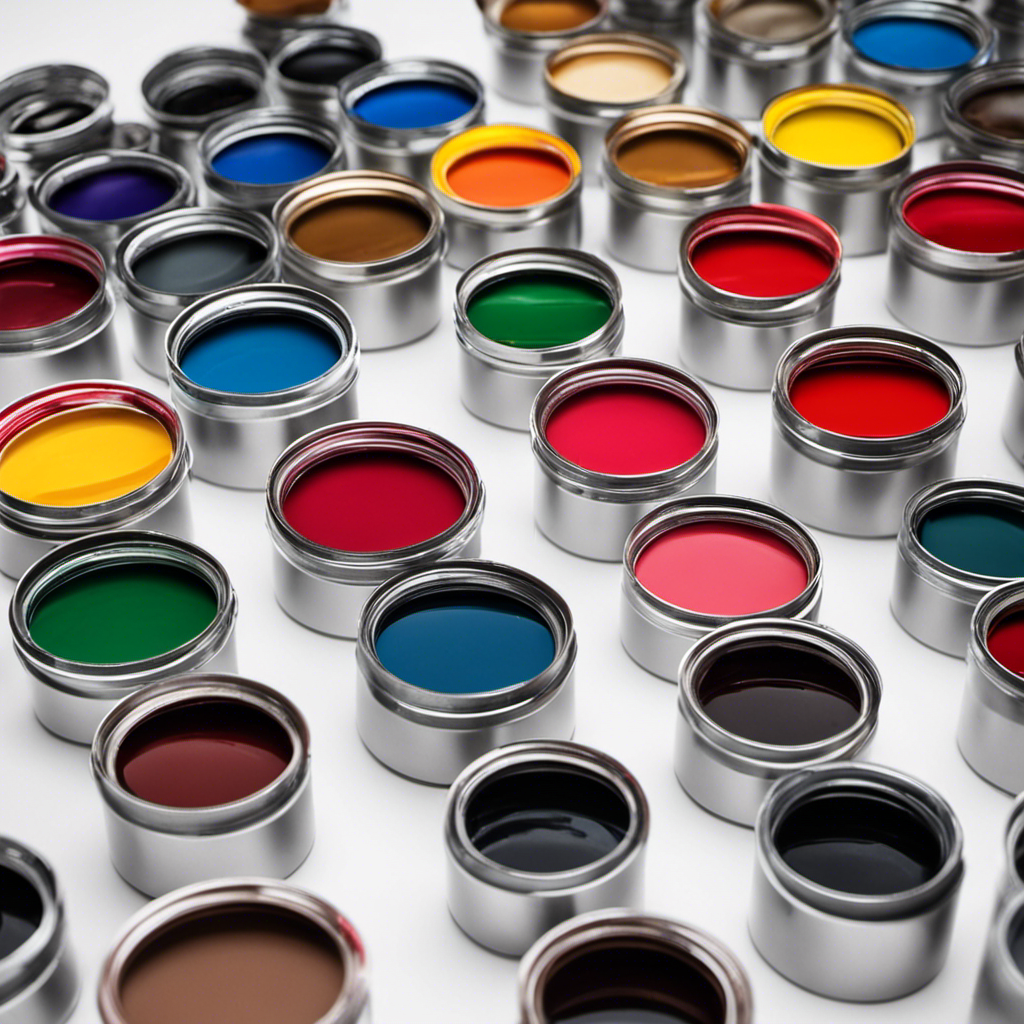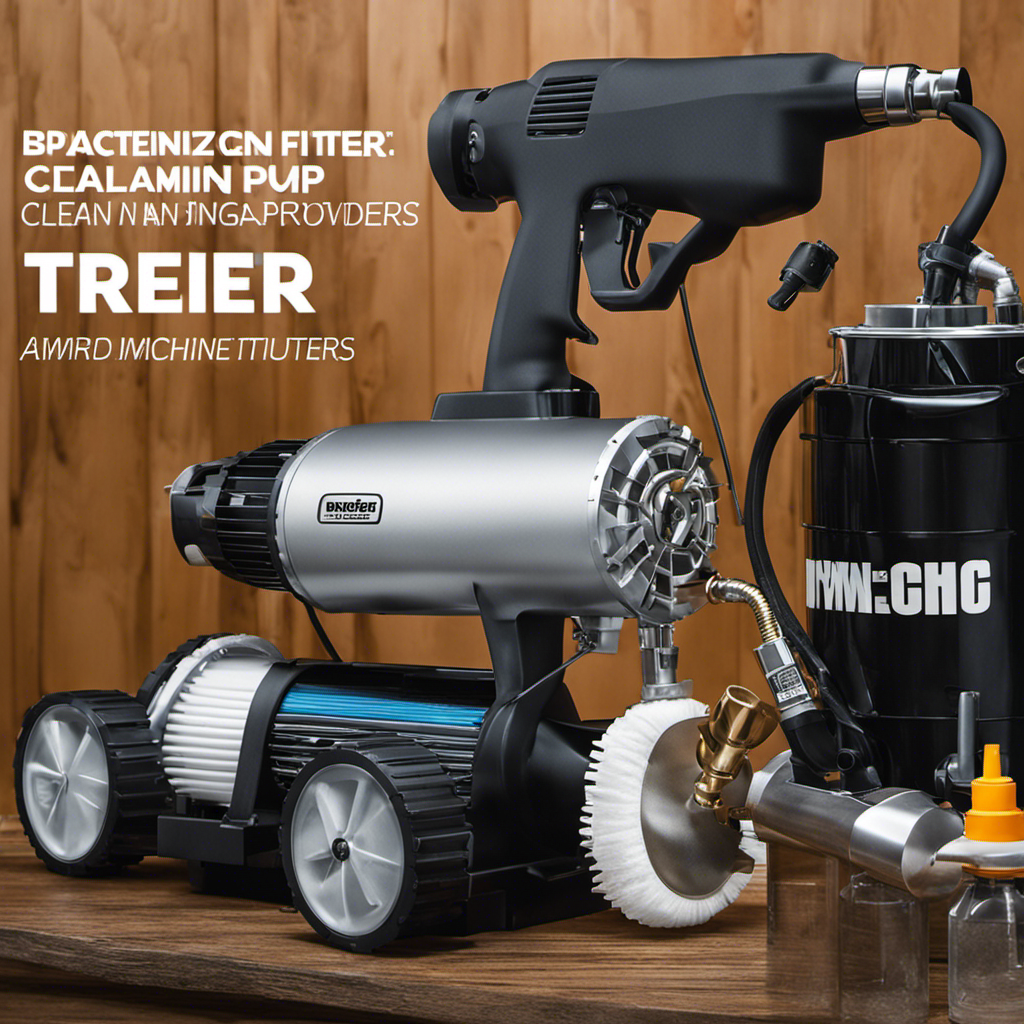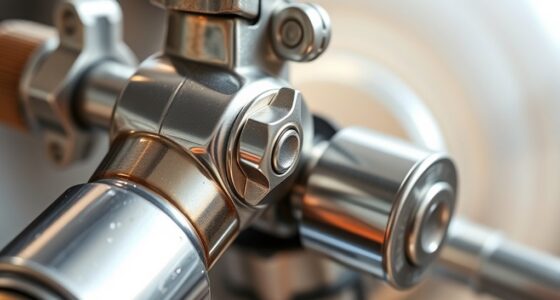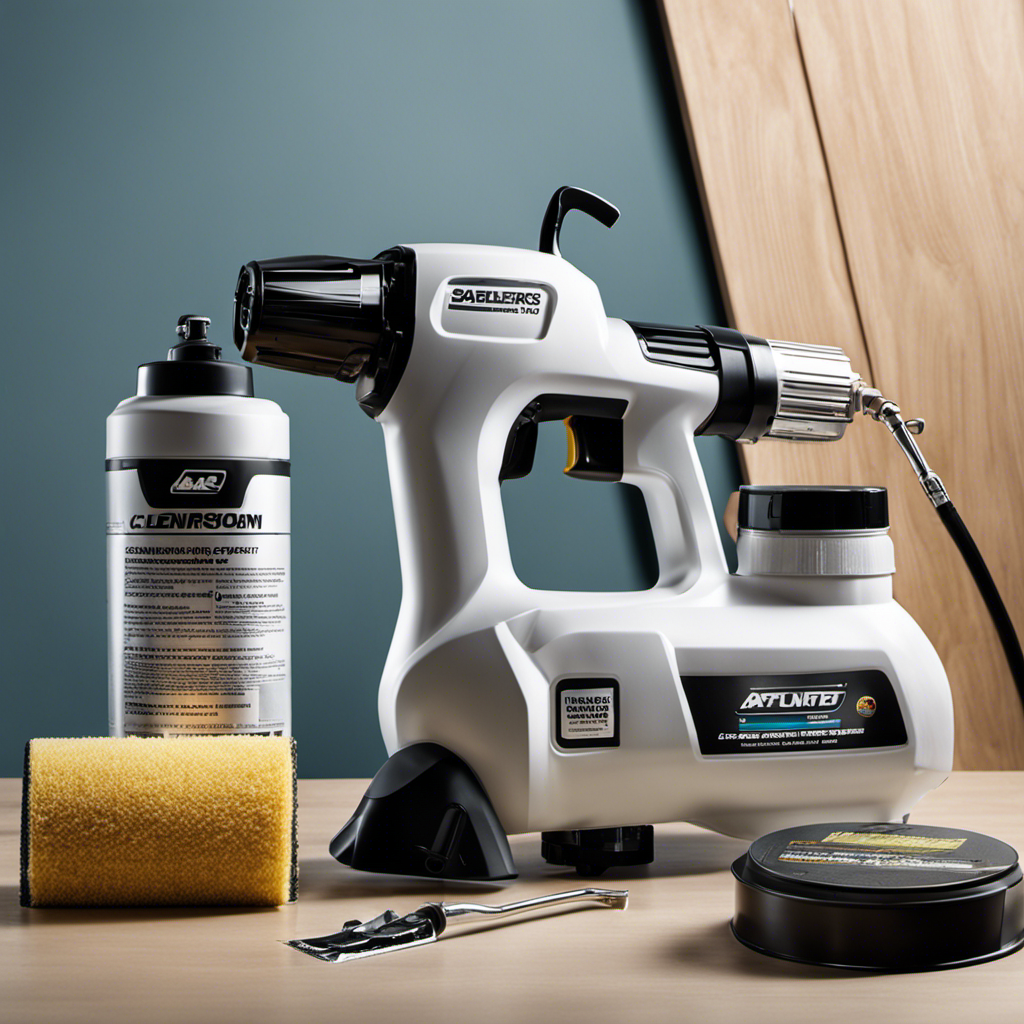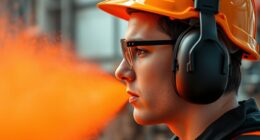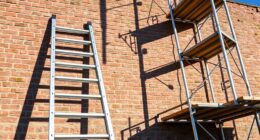For achieving a professional and seamless result using the Krause and Becker Airless Paint Sprayer, it is vital to choose the right tips.
Did you know that using the right tip size can make a significant difference in the texture effect and overall outcome of your painting project?
With tip sizes like 515, 517, and 619, each offering unique advantages and disadvantages, it’s important to understand how to choose the perfect tip for your specific needs.
This article will provide you with all the knowledge you need to make the best tip selection, ensuring optimal results every time.
Key Takeaways
- Choose the right tips compatible with the Krause and Becker airless paint sprayer
- Select the appropriate tip size for desired texture effect
- Adjust the pressure settings accordingly
- Practice on a test surface before applying the texture
Importance of Choosing Compatible Tips
Choosing the right compatible tips for the Krause and Becker airless paint sprayer is essential in achieving a professional and flawless finish. There are several factors to consider when choosing the tip size, including the type of surface and desired spray pattern.
The tip size will determine the texture effect of the paint finish. It is recommended to practice on a test surface before applying the texture to ensure the desired result. This allows for adjustments to be made in terms of pressure settings and technique. By practicing on a test surface, one can also determine if a different tip size is needed.
Overall, selecting the right tip size and practicing on a test surface will greatly enhance the quality of the paint job and ensure a satisfactory outcome.
Factors to Consider When Selecting Tip Size
To achieve the desired texture effect with the Krause and Becker airless paint sprayer, it is important to consider several factors when selecting the appropriate tip size.
One factor to consider is the type of surface being painted. Different surfaces may require different tip sizes to achieve the desired effect. For example, smooth surfaces may require a smaller tip size, while rough or textured surfaces may require a larger tip size.
Another factor to consider is the desired spray pattern. The tip size selection will depend on the width of the spray pattern desired. A wider spray pattern may require a larger tip size, while a narrower spray pattern may require a smaller tip size.
The type of material being sprayed is also an important consideration. Thicker materials, such as paint or coating, may require a larger tip size, while thinner materials may require a smaller tip size.
Lastly, the desired finish should be taken into account when selecting the tip size. Different tip sizes will produce different finishes, so it is important to choose the size that will achieve the desired result.
Adjusting Pressure Settings for Optimal Results
Adjusting the pressure settings on the airless paint sprayer is crucial for achieving optimal results. When working with different materials, it is important to adjust the pressure accordingly.
For thin materials and fine finish work, a lower pressure setting is recommended, while thicker materials and heavy-duty coatings require a higher pressure setting.
Troubleshooting common problems with pressure settings involves checking for clogs or blockages in the spray gun, hose, or tip. If there are any issues, it is important to clean or replace the affected parts.
Additionally, it is important to ensure that the pressure settings are consistent throughout the entire painting process to maintain a consistent spray pattern and coverage.
Practicing on a Test Surface Before Painting
Before painting, it is essential for the user to practice on a test surface to ensure they are comfortable with the spray pattern and achieve the desired texture effect. This step is crucial for mastering the technique and troubleshooting common issues that may arise during the painting process.
By practicing on a test surface, the user can familiarize themselves with the airless paint sprayer and its settings, such as pressure adjustments and tip selection. This allows them to troubleshoot any problems that may occur, such as uneven spray patterns or clogging.
Additionally, practicing techniques on a test surface helps the user understand the proper distance and speed at which to move the sprayer, resulting in a more professional and consistent finish.
Following Manufacturer’s Recommendations for Tip Maintenance
The user should always follow the manufacturer’s recommendations for maintaining the tips on their airless paint sprayer. Proper maintenance of the tips is crucial for prolonging their lifespan and ensuring optimal performance.
There are several factors to consider when maintaining paint sprayer tips. Firstly, it is important to clean the tips thoroughly after each use to prevent clogs and blockages. Use a suitable cleaning solution and a brush to remove any paint residue or debris.
Secondly, inspect the tips regularly for any signs of wear or damage. Replace them if necessary to avoid compromising the quality of the spray pattern. Additionally, lubricating the moving parts as recommended by the manufacturer will help keep the tips in good working condition.
Lastly, store the sprayer in a clean and dry environment to prevent corrosion or damage to the tips. By following these tips, users can prolong the lifespan of their paint sprayer tips and ensure consistent and high-quality results.
Tips for Achieving a Professional Finish
To achieve a professional finish, users should experiment with different tip sizes and orifice sizes to create desired textured or smooth and glossy finishes.
Here are some tips for proper paint sprayer technique and common mistakes to avoid when using an airless paint sprayer:
- Hold the sprayer perpendicular to the surface for even coverage and avoid tilting it at an angle.
- Maintain a consistent distance between the sprayer and the surface to prevent overspray or uneven application.
- Move the sprayer in a smooth and steady motion, overlapping each pass to ensure complete coverage.
- Avoid spraying too quickly or too slowly, as it can result in drips or uneven texture.
Considering Surface Type and Spray Pattern
Consider the type of surface and desired spray pattern when selecting the appropriate tip size for the Krause and Becker airless paint sprayer. The tip size plays a crucial role in determining the width and intensity of the spray pattern.
For example, a smaller tip size will result in a narrower and more concentrated spray pattern, while a larger tip size will produce a wider and more diffuse spray pattern. Users can choose from a variety of tip sizes, ranging from smaller sizes like 515 for fine finishes to larger sizes like 619 for heavy-duty coatings.
When comparing tip sizes, it’s important to also consider the material being sprayed and the desired texture or smoothness of the finish. Additionally, users should choose tip materials that are compatible with the specific paint or coating being used to ensure optimal performance and durability.
Different Sizes and Materials of Compatible Tips
When selecting the appropriate tip size for the Krause and Becker airless paint sprayer, users should take into account the desired finish and the specific material being sprayed. Different materials require compatible tips to achieve a flawless finish.
Here are some tips for achieving a professional result:
-
Consider the type of surface and desired spray pattern when choosing the tip size. The right tip size will ensure optimal coverage and minimize overspray.
-
Adjusting the spray pattern is essential for achieving the best results. A wider tip with a larger fan width is ideal for larger surfaces, while a narrower tip with a smaller fan width provides better control for more detailed work.
-
Select a tip that is better suited for different types of paint or coatings. Different materials require different tip sizes and orifice sizes for optimal application.
-
Experiment with different tip sizes and orifice sizes to achieve desired textured or smooth and glossy finishes. Adjusting the pressure settings on the paint sprayer according to the desired finish greatly impacts the outcome.
Advantages and Disadvantages of Specific Tip Sizes
The 515 tip size offers a fine finish but may not be suitable for thicker materials. It is important to consider the advantages and disadvantages of different tip materials and compare tip sizes for different types of paint or coatings.
The 515 tip, made of stainless steel, provides excellent atomization and a smooth finish. However, it may struggle with thicker materials, resulting in clogs or an uneven spray pattern.
On the other hand, larger tip sizes like the 517 or 619 are better suited for thicker materials and heavy-duty coatings. These larger tips allow for better material flow and reduce the risk of clogging. However, they may not provide the same level of precision and fine finish as the smaller tip sizes.
It is important to choose the right tip size based on the specific requirements of your painting project.
Tips for Achieving Different Finishes and Effects
When using a Krause and Becker airless paint sprayer, selecting the right tip size is crucial for achieving different finishes and effects. Here are some tips for selecting the appropriate tip size and adjusting pressure settings:
-
Consider the desired texture effect: Choose a tip size that corresponds to the texture effect you want to achieve. For fine finishes, opt for a smaller tip size, while larger tip sizes are suitable for thicker materials and heavy-duty coatings.
-
Test on a small surface: Before applying the texture to the entire area, practice on a test surface to ensure the chosen tip size and pressure settings deliver the desired result.
-
Adjust the pressure settings: Experiment with different pressure settings to find the optimal one for your chosen tip size. Higher pressure settings generally result in a smoother finish, while lower settings create a more textured effect.
-
Follow the manufacturer’s recommendations: Always refer to the manufacturer’s guidelines for specific tips and pressure settings for the best performance and longevity of your Krause and Becker airless paint sprayer.
Using Wider or Narrower Tips for Specific Surfaces
To cover larger surfaces more efficiently, users can use wider tips with larger fan widths on the Krause and Becker airless paint sprayer. Choosing the right tip size for different textures is crucial for achieving the desired finish.
When it comes to using wider or narrower tips, there are several benefits to consider. Using a wider tip with a larger fan width is ideal for larger surfaces as it allows you to cover more area in less time. This is particularly useful for projects that require quick and efficient painting, such as painting walls or fences.
On the other hand, using a narrower tip with a smaller fan width provides better control and precision, making it suitable for more detailed work or smaller surfaces.
Whether you need to cover a large area quickly or require more accuracy in your painting, selecting the appropriate tip size can greatly impact the outcome of your project.
Selecting the Right Tip for Different Types of Paint or Coatings
Users can achieve optimal results by selecting the right tip size for different types of paint or coatings when using the Krause and Becker airless paint sprayer. There are several factors to consider when selecting tip size for the best outcome. Here are some tips for achieving a professional finish:
-
Material Compatibility: Consider the type of paint or coating you will be using. Different tip sizes are designed for specific materials, such as thin or thick paints.
-
Surface Texture: Determine the desired texture effect. A smaller tip size will create a smoother finish, while a larger tip size will produce a more textured appearance.
-
Spray Pattern: Adjust the pressure settings on the paint sprayer to control the spray pattern. This will help achieve an even and consistent coverage.
-
Practice and Experiment: Before applying the paint or coating, it is recommended to practice on a test surface. This allows you to familiarize yourself with the sprayer and fine-tune your technique.
Adjusting Pressure Settings for Desired Finish
Adjusting the pressure settings on the Krause and Becker airless paint sprayer is essential for achieving the desired finish. Different textures require different pressure levels to ensure optimal results.
To adjust the pressure settings, start by turning the pressure control knob clockwise to increase the pressure or counterclockwise to decrease it. It is important to troubleshoot common issues that may arise with pressure settings.
If the paint is spattering or uneven, the pressure may be too high. Lower the pressure gradually until the desired consistency is achieved.
On the other hand, if the paint is not atomizing properly or the finish is too light, the pressure may be too low. Increase the pressure gradually until the desired texture and coverage are obtained.
Experimenting With Tip and Orifice Sizes for Desired Finishes
After adjusting the pressure settings, the next step in achieving the desired finish with a Krause and Becker airless paint sprayer is to experiment with tip and orifice sizes.
By using alternative tip sizes, painters can create unique texture effects on their surfaces. This allows for more creative freedom and customization in their projects.
Additionally, exploring different materials for compatible tips can further enhance the painting experience. Certain materials may provide better results or a smoother application depending on the desired finish.
Ultimately, the goal is to find the perfect combination of tip size and material that will result in the desired texture and finish. By experimenting and trying different options, painters can achieve truly remarkable results with their Krause and Becker airless paint sprayer.
Frequently Asked Questions
How Do I Choose Compatible Tips for the Krause and Becker Airless Paint Sprayer?
Choosing compatible tips for the Krause and Becker airless paint sprayer is an important step in achieving a professional finish. When selecting tip size, consider the desired texture effect and the type of surface you are painting.
It is also essential to adjust the pressure settings accordingly. The Krause and Becker airless paint sprayer is compatible with tips like 515, 517, and 619, each with their own advantages and disadvantages.
Experiment with different tip sizes to achieve your desired finish.
What Factors Should I Consider When Selecting the Tip Size for the Desired Texture Effect?
When selecting the tip size for the desired texture effect, there are several factors to consider.
Firstly, the type of texture you want to achieve will determine the appropriate tip size. For a finer texture, a smaller tip size should be chosen, while a larger tip size will produce a more pronounced texture.
Additionally, the type of material being sprayed and the pressure settings on the paint sprayer will also impact the texture effect.
How Do I Adjust the Pressure Settings for Optimal Results With the Airless Paint Sprayer?
To adjust the pressure settings for optimal results with the airless paint sprayer, first, ensure that the sprayer is turned off.
Locate the pressure control knob on the sprayer, usually found near the pump or motor. Turn the knob clockwise to increase the pressure and counterclockwise to decrease it.
Start with a lower pressure setting and gradually increase it until you achieve the desired spray pattern and coverage.
If encountering issues such as uneven spray or excessive overspray, adjusting the pressure can help troubleshoot these common problems.
Why Is It Important to Practice on a Test Surface Before Applying the Texture?
It is important to practice on a test surface before applying texture to ensure a professional and flawless finish. By doing so, one can assess the compatibility of the chosen tips with the Krause and Becker airless paint sprayer, as well as the desired texture effect.
This allows for adjustments in pressure settings and spraying techniques, optimizing the outcome. Surface preparation plays a crucial role in achieving the best results, and practicing on a test surface helps in identifying any potential issues and refining the application process.
What Are the Manufacturer’s Recommendations for Tip Maintenance With the Krause and Becker Airless Paint Sprayer?
The manufacturer’s recommendations for tip maintenance with the Krause and Becker airless paint sprayer involve regular cleaning and inspection. It is important to clean the sprayer after each use to prevent clogs and blockages.
Lubricating the moving parts as recommended by the manufacturer is also crucial. Additionally, it is essential to inspect all parts for wear or damage and replace them if necessary.
Storing the sprayer in a clean and dry environment and following safety guidelines when handling and storing cleaning solutions and paint materials is advised.
Conclusion
In conclusion, selecting the compatible tips for the Krause and Becker Airless Paint Sprayer is crucial in achieving professional and flawless results. By considering factors such as tip size, pressure settings, and surface type, users can optimize their painting experience.
Following the manufacturer’s recommendations for tip maintenance is essential for preventing clogs and ensuring the longevity of the sprayer. By experimenting with different tip sizes and pressure settings, users can achieve their desired finishes, whether it’s covering large surfaces efficiently or achieving precise and detailed work.
So, choose the right tip and unleash your creativity to create stunning and professional-looking paint jobs.
Franz came aboard the Paint Sprayer Zone team with a background in both journalism and home renovation. His articulate writing style, combined with a passion for DIY projects, makes him an invaluable asset. Franz has a knack for breaking down technical jargon into easy-to-understand content, ensuring that even the most novice of readers can grasp the complexities of paint sprayers.
